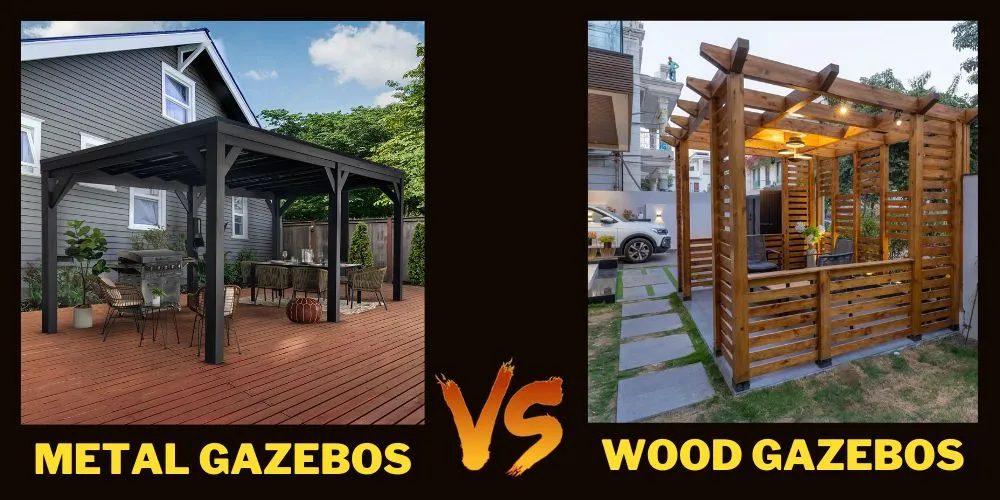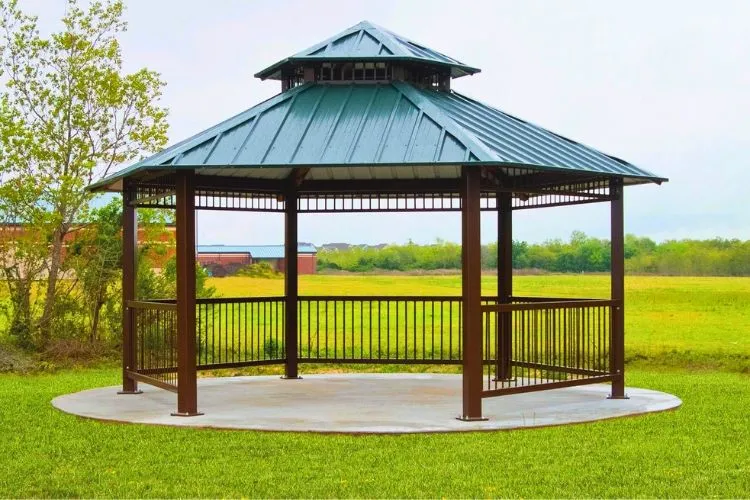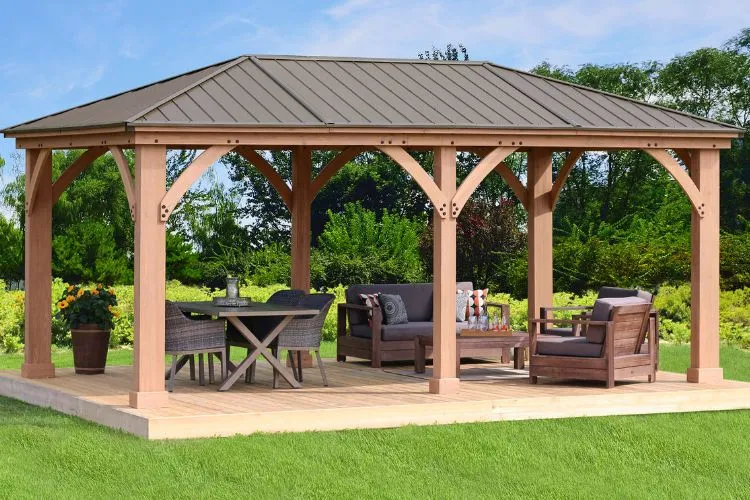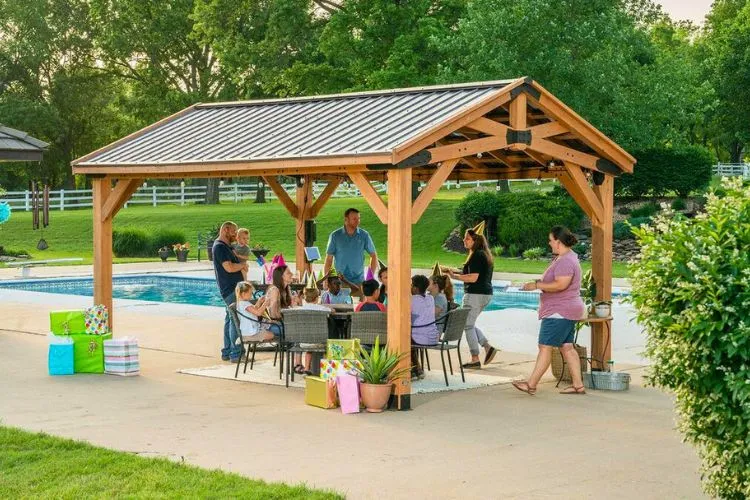When it comes to adding a gazebo to your outdoor area, the choice between metal and wood can be a significant one.
That’s why it becomes important to discuss metal vs wood gazebos in detail, because these structures not only offer a beautiful aesthetic touch but also serve functional purposes.
Whether for lounging, dining, or providing a focal point in your garden, a gazebo can be a delightful addition.
To make an informed decision, it’s crucial to understand the differences between metal and wood gazebos, including their advantages, disadvantages, and the various factors that might influence your choice.

Contents
Understanding Gazebos
A gazebo is traditionally a pavilion structure, sometimes octagonal or turret-shaped, that provides a place of shelter and relaxation in a garden or yard.
Gazebos are open from all sides, offering an unobstructed view of the surrounding area, making them perfect for enjoying the beauty of the outdoors while still being protected from direct sunlight or rain.
The Historical Significance of Gazebos
Historically, gazebos have been utilized as ornamental features in the gardens of the wealthy and in public spaces.
They originated in the ancient civilizations of Egypt, Persia, and Rome, where they were used as garden features.
Over time, their popularity spread to different parts of the world, with each region adding its unique touch to the design.
Advantages and Disadvantages of Metal Gazebos
Materials Used in Metal Gazebos
Metal gazebos primarily use materials like aluminum, steel, or wrought iron, each possessing unique properties.
Aluminum is lightweight and resistant to corrosion, which makes it ideal for areas with high humidity or seaside locations.
Steel offers immense strength and sturdiness, while wrought iron provides classic elegance with robust performance.

Pros of Metal Gazebos
One of the main advantages of metal gazebos is their durability. They can stand up to extreme weather conditions and, with proper coating and care, can last for many years without significant signs of wear.
Metal gazebos also tend to require less maintenance than wood structures. Designs in metal can be flexible, allowing for intricate details and modern architectural elements.
Cons of Metal Gazebos
Metal structures are not without their downsides. Iron and steel can rust when exposed to water, necessitating protective treatments.
The industrial look of metal may not blend as seamlessly into natural environments as wood.
Additionally, metal absorbs heat, which can make the gazebo hot and uncomfortable to use during high temperatures unless properly shaded.
Expert Tips for Metal Gazebos
When opting for a metal gazebo, select aluminum if you live in a wet climate to avoid issues with rust. For steel and iron structures, ensure regular application of protective sealants.
Adding accessories such as curtains or privacy screens can help mitigate the heat absorption issue and add an aesthetic charm.
Advantages and Disadvantages of Wood Gazebos
Materials Used in Wood Gazebos
Wood gazebos commonly use species like cedar, redwood, or pine.
These types of wood are chosen for their natural beauty and their inherent resistance to environmental elements such as rotting and insects, making them suitable for outdoor use.

Pros of Wood Gazebos
Wood is known for its warm and inviting aesthetic, making it a popular choice for those seeking a traditional or natural look in their garden structures.
Additionally, wood does not heat up as quickly as metal, providing a cooler area to relax even during warmer days. With the right care, wood can be very durable and remain an appealing feature in your garden for years to come.
Cons of Wood Gazebos
Wood gazebos are typically more high-maintenance than metal ones. They need regular treatments to protect against water damage, UV radiation, and pests.
The cost of a wood gazebo, particularly those made from high-quality lumber like cedar or redwood, can also be more substantial than a metal counterpart.
Expert Tips for Wood Gazebos
For a wood gazebo, choosing high-grade, resistant wood such as cedar or redwood is advised.
These woods offer natural resistance to decay and pests, reducing the need for frequent treatments.
To preserve the wood and maintain its appearance, apply a water repellent or a quality sealant every few years.
Metal Vs Wood Gazebos: An Honest Comparison
Durability and Maintenance
Metal gazebos usually provide more straightforward maintenance routines and are known for outlasting wood structures when properly maintained.
On the other hand, wooden gazebos require a more vigorous maintenance schedule to keep them resistant to the elements and pest infestation.
Cost Implications
Streamlined maintenance and longevity often make metal gazebos more cost-efficient over the years.
While wood gazebos have higher upfront costs, especially if made from premium lumber, some may prefer wood for its aesthetic and willingness to invest in upkeep.
Aesthetics and Custom Design
The choice of material often hinges on individual aesthetic preferences. Those looking for contemporary vibes may lean towards metal, while wood offers a timeless, classic feel that easily blends with nature.
Both materials can be designed to various tastes and specifications, allowing for personalization.
Environmental Considerabilities
For environmentally conscious consumers, wood can be the more sustainable choice if it comes from responsibly managed forests.
Metal gazebos made from recycled materials also offer an eco-friendly alternative, despite metal processing generally requiring more energy.
Additional Gazebo Considerations
DIY Preferences in Gazebo Construction
Individuals who enjoy do-it-yourself projects may find wood a more accessible material to work with due to its versatility and the relative simplicity of tools needed for modifications or repairs.

Weather Adaptation for Gazebos
In climates that expose outdoor structures to varied weather conditions, it is essential to select a material that will stand up to the local environment. Aluminum and treated wood options can adjust well to different weather challenges.
Gazebos and Longevity
While a well-maintained metal gazebo can serve for decades with minor upkeep, a wood gazebo also promises longevity if regularly treated and cared for, although it may require more attentive maintenance over its lifespan.
Modifying or Moving Your Gazebo
Flexibility in alteration or relocation can be a factor in your choice of gazebo material. Wood is often more amenable to changes than metal, providing the option for modifications should your preferences or needs evolve.
Choosing the best gazebo for your outdoor space can enhance your property’s value and your enjoyment of your outdoor area.
Whether you opt for the sturdy longevity of metal or the natural beauty of wood, ensure that your selection aligns with your lifestyle needs and aesthetic desires.
Conclusion:
The right choice between metal and wood for your gazebo comes down to what you value most—durability, maintenance, cost, design, or environmental impact.
While each material presents distinct benefits and setbacks, your specific needs and circumstances will dictate the most satisfying and sensible option.

Sergio Gomes, a passionate advocate for outdoor living and the male voice behind Shades Authority. With years of experience, Sergio is your trusted source for expert insights on gazebos, pavilions, cabanas, pergolas, and all things outdoor shade solutions. Join him on a journey to transform your outdoor spaces into stunning, functional retreats
